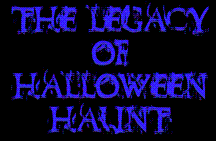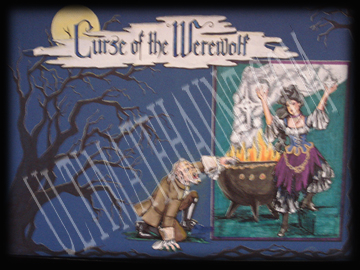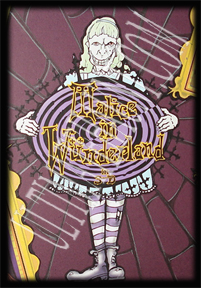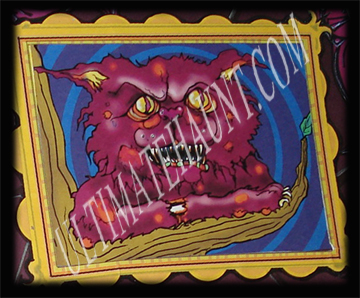
DANIEL MILLER - PART I- PAGE 2 OF 2
Wow! [laughs] Typically, we do start the day after Haunt closes, because we have to. We don’t have the storage space to store everything and that’s the truth of it. We have to know what to tear apart and throw out or what will be used again. That’s a major factor of how the ball starts rolling.
From that point on, we don’t really touch it for a while. We talk
about broad things….”How about Vegas? Let’s do a twisted
Vegas. How about a Malice in Wunderland?”
 Storyboard - Curse of the Werewolf |
There are also things that we need to maintain. We need to maintain two to three mazes that are U.V. [“ultra violet” 3-D mazes], so we kind of know what the best theme for U.V. would be.
There’s a whole list of things that we can do. We kind of separate them, “this is something that we can do that is kitschy and this is something that can do that’s really scary that will freak people out”. We just weed through them and present it and say, “this is what I would like to do”.
Around February or March, we really decide what the themes are and solidify where the mazes are going to be (which is a Jack Falfas and Charles Bradshaw [Entertainment Director] decision).
Now, for example, let’s say I get one maze. So, let’s say Malice in Wunderland for this example.
That was a U.V. maze. We wanted something that was scary and knew that U.V. was huge at the time. We couldn’t do this successfully unless it was both colorful and scary. That is very difficult. You guys at home, try that. It is not easy.
One thing that we struggled with Malice greatly was the copyright issue.
We had to do a little bit of research but the book by Lewis Carroll is public domain. Everyone kept asking, “How can you do that theme? It’s Disney!” The answer, is no, it’s Lewis Carroll. Disney owns the rights to that particular look. They own that particular cartoon image of "Alice in Wonderland". So, we changed it to Malice in Wunderland.
 |
Once the legalities were sorted out, we knew that it would be going into the bumper cars.
In fact, I’m not sure how many people realize this but I didn’t change much from the previous maze. The year before, it was Elvira’s Nightmares. I reversed the order of the rooms. They were the same shape, for the most part. But with just a little bit of tweaking, it looked completely different.
First, we write a script which follows the basic format of the original story of "Alice in Wonderland" (which we twisted to our liking). Then we take the bumper car ground plan, which is top view. The scale is a quarter inch equals a foot. We then draft all of the rooms.
We knew we had to start with a spinning tunnel because of the “falling down the rabbit hole” scene, which is what we need to recreate. But a tunnel wouldn’t fit with the low ceiling of the bumper cars venue. So we decided to extend the maze to the outside.
What we tend to do is create an effect or something that will slow down the guests at the beginning of the maze to allow a little bit of space for the rest of the maze between the guests. We like to try and create that as much as possible.
Our ground plans have to be in ‘code’ --75 feet to each emergency
exit anywhere inside the maze. It needs to be approved by the Fire Marshall.
The hallways have to be four feet wide with five foot turn radiuses for
A.D.A. compliance. They also have to be ramped up and ramped down.
When the ground plan is finished,
we do a costume summary, which lists all of the characters. Typically,
we do three characters per “breaker” (monsters reading this
will know this). We put together the mask summary as well as choose the
masks. We use the Morris catalog for the most part. We
list what prop(s) the characters need. And we give this information over
to costuming. Tim Barham is in charge of wardrobe and costuming as well
as Bill Meier.
Then we make lists of props that will go in each room. We try to get as detailed as possible. We list everthing from furniture to decapitated heads. We let the Prop Department know about anything they may have to sculpt or carve. There was a lot of carving and sculpting in Malice.
Then we write effects list. There were a lot of animatronic effects in Malice (the Cheshire Cat, the Caterpillar). We have a whole FX Department that makes all of those effects.
 |
We’re looking at a maquette(Model Sculpture) right now of the Caterpillar that I gave to the FX Department. They came up with the movement. Design controls the look of it and FX make it come to life. They’re incredible.
We also have to give the Paint Department paint elevations. Malice was a heavily painted maze. Tamara Lujon was the head painter at the time. The painting in that maze was top notch and set the bar.
What we tend to do as designers is we’ll do one sample wall of what it should be. And the painters will take it and expand on the idea. At that point, we’re there to help them and guide them, but they use their own creativity. They get involved in it and the maze turns into this living being. They always put their hearts and souls into the work, more than I could imagine.
From there, we list the Sound Effects. I just give the Sound Department suggestions and they collect all of the music and sound effects. For example, “Okay, in this room, we need Malice screaming. And in this room, it has to have coughing because the Caterpillar is smoking his pipe”. Each room gets its own sound effect.
Basically, the overall maze gets one soundtrack. For that year, it was Adam Hankinson and Rob Perez that put all of the sound together. I have gotten pretty intimate with the sound process. In fact, a lot of the voices in the Asylum are me just mumbling. We try to grab as many people as possible to help out with the sound.

Lighting is the last list we come up with. We just do an Excel spreadsheet of all of the different looks we want and the Lighting Department goes in and puts up all of the lights. We basically get the mood we want. For example, “Uplighting on the Caterpillar to make it look scary". Or, we’ll just request a blue light for another area.
So, going back a bit, we distribute the lists to the different departments and we have breakout meetings on each maze and will walk through the ground plan so we all understand everything.
The carpenters get the first hack at the maze. They are an incredible group. A lot of monsters work as the carpenters. They are talented people that know how to build. God bless them!
In each of these departments, we give them wide latitude because we know that it’s a lot of work. Anyone who has worked the event knows that it takes incredible effort to make Haunt happen.
The designers work on the shoulders of the giant. They are incredibly gifted and hard workers.

MAZES & ATTRACTIONS FOR 2007:
BEOWULF LABYRINTH INTO DARKNESS - THE LAKE
PYROMANIAX - LOG RIDE
THE DOLL FACTORY - WILDERNESS DANCE HALL
KILLER CLOWN KOLLEGE - XCELERATOR
BLACK WIDOW'S CAVERN - MINE RIDE
LORE OF THE VAMPIRE - BALLOON RACE
ASYLUM - GHOSTRIDER 1
RED BEARD'S REVENGE - MAIN GATE
FEARY TALES - GHOSTRIDER 2
13 AXE MURDER MANOR - MYSTERY LODGE
THE GRUDGE 2 - FIESTA PLAZA
LOST VEGAS - BUMPER CARS
DARK REALM LAZER RAGE - STAGECOACH TRAIL
SCARE ZONES:
GHOST TOWN, THE GAUNTLET, CARNEVIL AND SILVER BULLET MINING TOWN
SHOWS:
THE HANGING - CALICO SQUARE
HACKS - KNOTT'S GHOUL TIME THEATRE
THE DEATH OF DR. CLEAVER - BIRD CAGE THEATER
(The above-outlined list may be subject to change. However, keep your eyes peeled on Ultimatehaunt.com as Knott's Berry Farm releases the details of the 2007 Halloween Haunt on their website)